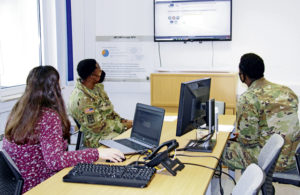
Training Soldiers to help other Soldiers live more comfortably is a people-first initiative the housing office continues to carry out through its barracks management training.
Barracks manager training conducted by the Army housing office here has continued through the pandemic during one of the busiest and tumultuous permanent-change-of-station ‘seasons’ on record. As PCSing families move into Baumholder houses, unaccompanied Soldiers must also have quarters in one of the 87 barracks buildings on the garrison’s vast footprint.
“Where a Soldier lives is an important factor in preserving and enhancing the Army’s all-volunteer force,” said Harald Kastner, chief of the housing office. “The barracks is their home. Quality facilities and essential services are essential elements to those Soldiers living there.”
Through socially distanced, mask-protected learning sessions, the housing office team delivers training to about 65-75 eligible Soldiers each year. The garrison’s barracks are home to about 2,600 troops from units across the globe on sites in Kaiserslautern and Baumholder.
The in-person training takes two-and-a-half hours. Barracks managers find much of what they need to know in the 101-page “Army Barracks Management Program Handbook.” The book details facility maintenance, inspections, property management practices, and more.
Silke Drumm, unaccompanied housing branch manager, said understanding and updating the Enterprise Military Housing database is the most critical part of the training. EMH helps perform barracks room assignments, terminations, furnishings, accountability, inspections, and utilization. The database provides leaders with real-time data on where Soldiers live, occupancy status, maintenance requirements, and inspection history. EMH data is a source cited in reports by the DOD Inspector General and others.
“This is the most important thing they do to take care of the Soldiers,” said Drumm, referring to continuous, accurate update of EMH. “We want Soldiers to feel welcome, have a clean, serviceable room to live in, and ensure that when they leave, they leave the room ready for whoever lives there next.”
Another tech tool assisting barracks managers is the new Army Maintenance Application. The app puts room and building repairs as close as a mobile phone or tablet. Linked within the Digital Garrison app, the maintenance app finished a pilot program in 2020 and is making its way to Soldiers’ phones in 2021.
While all the tech resources are helpful, for the barracks manager cadre, Drumm said the one resource that is a necessity to success is hard to come by: time.
“The quality of the Soldiers we get for barracks managers is great. They are fast and great with computers!” she said. “But, they also need a little more time to do monthly walkthroughs to check cleanliness, do regular furniture inventory, and more. They don’t have the time to do it, but they need it.”
Staff Sgt. Dinel C. Taylor, 240th Quartermaster Supply Company, is the primary barracks manager for a building filled with fellow NCOs. He said using the training he received and doing the barracks management job well is a duty.
“I want to do a good job for my fellow NCOs,” said Taylor, pointing out the importance of ensuring Soldiers’ in- and out-processing via EMH. “If I do it right, and I take care of my fellow NCOs, then they will take care of me.”
Kastner said while there’s still work to be done, barracks managers and the training they receive is top-notch, according to a recent inspection.
“Our housing team and the barracks managers work well together,” Kastner said. “The training the barracks managers received also gained positive feedback.”
Taylor agreed. “The trainer taught the class and then walked us through the steps. What a great trainer and a great program!”


